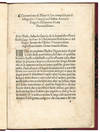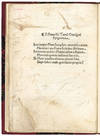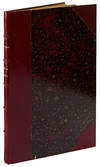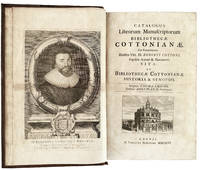first edition
15 September 1507 · Milan
by FREGOSO, Antonio (ca. 1460-ca. 1530)
EDITIO PRINCEPS
4to (199x135 mm). [10] leaves. Collation: a6 b4. Colophon at l. b4r. At the last leaf verso is an epigram by Francesco Tanzi. Woodcut decorative initials on black ground. Early 20th-century half morocco, gilt title on spine (Wood, London). On the front pastedown armorial bookplate "Biblioteca di Casate Vecchio". Marginal staining and light foxing, pale ink stain to the outer margin of the last five leaves, outer corner of the final leaf repared not affecting the text, old pen scribbles on the last leaf. A wide-margined copy from the libraries of Giuseppe Cavalieri (cf. T. De Marinis, ed., Catalogue des livres compasant la bibliothèque de M. Giuseppe Cavalieri à Ferrara, Florence, 1908, no. 784) and the bookseller Giuseppe Martini (with his typical pensil notes on the flyleaves, cf. E. Barbieri, ed., Da Lucca a New York a Lugano: Giuseppe Martini libraio tra Otto e Novecento, Florence, 2017), who writes that the book had also belonged to Charles Fairfax Murray (1849-1919).
Extremely rare first and only edition of this poem in 41 octaves. The Contentione di Pluto & Iro ('The Contention of Pluto and Irus') describes a dispute between Pluto, the god of wealth, and the beggar Arnaeus, or Irus. The contention ends without a winner and the two disputants are invited to seek the wise judgement of the President of the Milanese Senate, Iafredo Carlo, to whom the work is dedicated.
A unique case among Fregoso's works, the poem is also transmitted in a manuscript preserved today in the Biblioteca Ambrosiana in Milan, which however presents a more corrupted text than the printed edition; the latter in fact derives directly from the autograph that Fregoso himself probably entrusted to his friend Francesco Tanzi, the financer of the edition.
Antonio Fregoso (or Campofregoso or Fulgoso) Fileremo (or Filareno, i.e. lover of solitude) was probably born in Carrara, around 1460, the illegitimate son of Spinetta of the noble Genoese Fregoso family and lord of the city. Lacking male heirs, his father legitimised Antonio by an act later ratified by Emperor Frederick III. Spinetta, linked to the Duke of Milan Francesco Sforza, appointed in his will Cicco Simonetta as administrator of his estate and guardian of his son. After Spinetta's death in 1467, Fregoso lived with the latter in Milan. In 1472 Galeazzo Maria Sforza officially granted Milanese citizenship to Fregoso, but the following year Simonetta, as ducal minister, deprived him of Carrara and Lunigiana, which had passed to Federico Malaspina, rewarding him in exchange with the fief of Sannazzaro in Lomellina. In 1478, on the occasion of Gian Galeazzo Sforza's ducal appointment, Fregoso was made a knight. After a brief absence, he returned to Milan, where he married Fiorbellina Visconti di Lodrisio. In 1499 he swore allegiance to Louis XII when the latter conquered the Duchy of Milan, thus keeping his knighthood but losing the feud of Sannazzaro.
Fregoso then decided to retire to the villa in Colturano, on the road to Lodi, from where he sent his first works to Iafredo Carlo, president of the Milanese Senate. His retreat outside Milan did not, however, prevent him from frequenting the circles of Cecilia Gallerani and Ippolita Sforza Bentivoglio (as can be seen in the novelle I, 21 and III, 9 by M. Bandello). It is not clear what changes in Fregoso's life the succession in Milan of the Sforzas, French and Spanish after 1512 brought. He probably died around 1530. The fact that he is mentioned among the poets in the 1532 edition of L. Ariosto's Orlando furioso (XLVI, 16, v. 3 ff) does not serve to shift the terminus post quem since many of those mentioned in the poem were already dead at that date (V. De Matteis, Fregoso, Antonio Fileremo, in: "Dizionario Biografico degli Italiani", vol. 50, Rome, 1998, s.v.).
Respectively in 1506 and 1507 Fregoso published two poems, the Riso di Democrito ("Democritus' Laughter") and the Pianto di Heraclito ("Heraclitus' Weeping), each in fifteen chapters of tercets. Their translations into French by Michael d'Amboise (1547) and into Spanish by Alonso Lobera (1554) testify to the international fame of the two poems (often published together as I doi filosofi- 'The Two Philosophers').
The issue of fortune is presented in the form of a dialogue between the author, Lancino Curti and Bartolomeo Simonetta in the work Dialogo de Fortuna, first printed in Milan by Pietro Martire Mantegazza in 1507. No longer in tercets but in octaves is Fregoso's most famous work, the Cerva bianca ("The White Doe", Milan, Mantegazza, 1510).
In 1521 Fregoso vulgarised Lancino Curti's Silvae and in 1525 in Milan at Giovanni Giacomo Da Legnano and Bartolomeo da Crema's press he published his own 'silvae', also known as Opera nova, which includes Lamento d'Amore mendicante, Dialogo de musica, Pergoletta de le laudi de Amore, Discorsi cottidiani non vulgari, De lo istinto naturale, De la probità and De i tre peregrini (cf. A. Dobelli, L'opera letteraria di Antonio Fregoso Fileremo, Modena, 1898).
"In definitiva prodotti come quelli del Fregoso stavano a testimoniare, nel primo ventennio del '500, la vitalità di una 'letteratura mista e multiforme, drammatica, narrativa, allegorica, pronta a ogni sorta di esperimenti e però sufficientemente sciolta dall'impaccio delle regole... letteratura tutta moderna, se anche variamente assistita da antichi modelli classici e volgari'. E ne rende fede quel mannello di presenze raccolte intorno al Fileremo, vuoi interlocutori dei suoi dialoghi, vuoi pubblici laudatores delle sue imprese poetiche: editori, poeti nell'una e nell'altra lingua, letterati, oratori, quegli stessi che si ritrovano se si ha la pazienza di seguire certi fili che porge il sistema delle dedicatorie bandelliane: gli esponenti insomma di una cultura legata in fondo ancora alle sue origini cortigiane e destinata nel terzo decennio del '500 a frantumarsi per 'un naturale e mirabile accordo della storia letteraria con quella politica' " (G. Dilemmi, Un capitolo della cultura settentrionale all'inizio del '500, in: A. Fregoso, "Opere", Bologna, 1976, pp. XXIX-XXX).
Edit 16, CNCE19866; USTC, 830970 (no copies in US libraries); E. Sandal, Editori e tipografi a Milano nel Cinquecento, Baden-Baden, 1981, vol. 3, no. 486; G. Dilemmi, Nota ai testi, in: A. Fregoso, "Opere", Bologna, 1976, pp. XLVII-XLVIII. (Inventory #: 223)
4to (199x135 mm). [10] leaves. Collation: a6 b4. Colophon at l. b4r. At the last leaf verso is an epigram by Francesco Tanzi. Woodcut decorative initials on black ground. Early 20th-century half morocco, gilt title on spine (Wood, London). On the front pastedown armorial bookplate "Biblioteca di Casate Vecchio". Marginal staining and light foxing, pale ink stain to the outer margin of the last five leaves, outer corner of the final leaf repared not affecting the text, old pen scribbles on the last leaf. A wide-margined copy from the libraries of Giuseppe Cavalieri (cf. T. De Marinis, ed., Catalogue des livres compasant la bibliothèque de M. Giuseppe Cavalieri à Ferrara, Florence, 1908, no. 784) and the bookseller Giuseppe Martini (with his typical pensil notes on the flyleaves, cf. E. Barbieri, ed., Da Lucca a New York a Lugano: Giuseppe Martini libraio tra Otto e Novecento, Florence, 2017), who writes that the book had also belonged to Charles Fairfax Murray (1849-1919).
Extremely rare first and only edition of this poem in 41 octaves. The Contentione di Pluto & Iro ('The Contention of Pluto and Irus') describes a dispute between Pluto, the god of wealth, and the beggar Arnaeus, or Irus. The contention ends without a winner and the two disputants are invited to seek the wise judgement of the President of the Milanese Senate, Iafredo Carlo, to whom the work is dedicated.
A unique case among Fregoso's works, the poem is also transmitted in a manuscript preserved today in the Biblioteca Ambrosiana in Milan, which however presents a more corrupted text than the printed edition; the latter in fact derives directly from the autograph that Fregoso himself probably entrusted to his friend Francesco Tanzi, the financer of the edition.
Antonio Fregoso (or Campofregoso or Fulgoso) Fileremo (or Filareno, i.e. lover of solitude) was probably born in Carrara, around 1460, the illegitimate son of Spinetta of the noble Genoese Fregoso family and lord of the city. Lacking male heirs, his father legitimised Antonio by an act later ratified by Emperor Frederick III. Spinetta, linked to the Duke of Milan Francesco Sforza, appointed in his will Cicco Simonetta as administrator of his estate and guardian of his son. After Spinetta's death in 1467, Fregoso lived with the latter in Milan. In 1472 Galeazzo Maria Sforza officially granted Milanese citizenship to Fregoso, but the following year Simonetta, as ducal minister, deprived him of Carrara and Lunigiana, which had passed to Federico Malaspina, rewarding him in exchange with the fief of Sannazzaro in Lomellina. In 1478, on the occasion of Gian Galeazzo Sforza's ducal appointment, Fregoso was made a knight. After a brief absence, he returned to Milan, where he married Fiorbellina Visconti di Lodrisio. In 1499 he swore allegiance to Louis XII when the latter conquered the Duchy of Milan, thus keeping his knighthood but losing the feud of Sannazzaro.
Fregoso then decided to retire to the villa in Colturano, on the road to Lodi, from where he sent his first works to Iafredo Carlo, president of the Milanese Senate. His retreat outside Milan did not, however, prevent him from frequenting the circles of Cecilia Gallerani and Ippolita Sforza Bentivoglio (as can be seen in the novelle I, 21 and III, 9 by M. Bandello). It is not clear what changes in Fregoso's life the succession in Milan of the Sforzas, French and Spanish after 1512 brought. He probably died around 1530. The fact that he is mentioned among the poets in the 1532 edition of L. Ariosto's Orlando furioso (XLVI, 16, v. 3 ff) does not serve to shift the terminus post quem since many of those mentioned in the poem were already dead at that date (V. De Matteis, Fregoso, Antonio Fileremo, in: "Dizionario Biografico degli Italiani", vol. 50, Rome, 1998, s.v.).
Respectively in 1506 and 1507 Fregoso published two poems, the Riso di Democrito ("Democritus' Laughter") and the Pianto di Heraclito ("Heraclitus' Weeping), each in fifteen chapters of tercets. Their translations into French by Michael d'Amboise (1547) and into Spanish by Alonso Lobera (1554) testify to the international fame of the two poems (often published together as I doi filosofi- 'The Two Philosophers').
The issue of fortune is presented in the form of a dialogue between the author, Lancino Curti and Bartolomeo Simonetta in the work Dialogo de Fortuna, first printed in Milan by Pietro Martire Mantegazza in 1507. No longer in tercets but in octaves is Fregoso's most famous work, the Cerva bianca ("The White Doe", Milan, Mantegazza, 1510).
In 1521 Fregoso vulgarised Lancino Curti's Silvae and in 1525 in Milan at Giovanni Giacomo Da Legnano and Bartolomeo da Crema's press he published his own 'silvae', also known as Opera nova, which includes Lamento d'Amore mendicante, Dialogo de musica, Pergoletta de le laudi de Amore, Discorsi cottidiani non vulgari, De lo istinto naturale, De la probità and De i tre peregrini (cf. A. Dobelli, L'opera letteraria di Antonio Fregoso Fileremo, Modena, 1898).
"In definitiva prodotti come quelli del Fregoso stavano a testimoniare, nel primo ventennio del '500, la vitalità di una 'letteratura mista e multiforme, drammatica, narrativa, allegorica, pronta a ogni sorta di esperimenti e però sufficientemente sciolta dall'impaccio delle regole... letteratura tutta moderna, se anche variamente assistita da antichi modelli classici e volgari'. E ne rende fede quel mannello di presenze raccolte intorno al Fileremo, vuoi interlocutori dei suoi dialoghi, vuoi pubblici laudatores delle sue imprese poetiche: editori, poeti nell'una e nell'altra lingua, letterati, oratori, quegli stessi che si ritrovano se si ha la pazienza di seguire certi fili che porge il sistema delle dedicatorie bandelliane: gli esponenti insomma di una cultura legata in fondo ancora alle sue origini cortigiane e destinata nel terzo decennio del '500 a frantumarsi per 'un naturale e mirabile accordo della storia letteraria con quella politica' " (G. Dilemmi, Un capitolo della cultura settentrionale all'inizio del '500, in: A. Fregoso, "Opere", Bologna, 1976, pp. XXIX-XXX).
Edit 16, CNCE19866; USTC, 830970 (no copies in US libraries); E. Sandal, Editori e tipografi a Milano nel Cinquecento, Baden-Baden, 1981, vol. 3, no. 486; G. Dilemmi, Nota ai testi, in: A. Fregoso, "Opere", Bologna, 1976, pp. XLVII-XLVIII. (Inventory #: 223)







![Publii Virgilii Maronis Opera, cum Servii commentariis, exactiori cura suae integritati restitutis. Habes item Io. Pierii Valeriani Castigationes, & Verietates lectionis in totum Virgilium […] Accedunt praeterea in omnia Virgili opera Stephani Doleti Annotatiunculae, Ioca obscura elucidantes, ac doctissimi Commentarii vicem fingentes. Additis novis quibusdam Io. Musonii viri quam eruditissimi lucubrationibus, quas inspexisse haud quaquam pigebit: [...]](https://d3525k1ryd2155.cloudfront.net/h/001/648/1692648001.0.m.jpg)